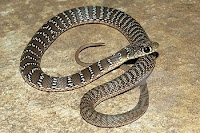
Saw Scaled Viper
(Echis Carinatus)
- Description: Saw scaled viper is a very venomous snake and is common throughout India. Body is short, Adults length measured between 300 - 500 mm (12 - 20 inc). Scales are strongly keeled and are rough in appearance. Head is broader then neck; scaled on upper surface of head are small and strongly keeled. Large eye has vertical pupil. Tail is very short and thin. Back has light, dark brown, brick-red, gray or sand-colored with zigzag patterns. Top of the head has usually distinct, arrow-head mark. Underside is white speckled with brown. Several different color forms exist. This snake is called Saw scaled Viper because it rubs sides of it's body together, producing a rasping sound. It is very ill-tempered snake and will attack any intruder. It's venom is highly hemotoxic and quite potent. Many deaths are attributed to this species. Found in a variety of environments, it is common is rural settlements, cultivated fields, arid regions, barns and rock walls. It is also found in deserts. This snake is very well camouflaged and due to the size, it is barely noticed by anyone.
Scalation of Saw-scaled viper

- Reproduction: Male combat observed. Female bared 4-8 living young between April - August. Female may produce two clutches a year. In Maharashtra (ratnagiri Dist. ) over 2000 Saw-scaled vipers were recorded in one week (July). The same area was visited in December and not a single snake could be found. Hibernation or aestivation in laterite crevices may account for this dramatic disappearance.
- Distribution: Saw-scaled vipers are found throughout India except West Bengal and the Northeast. Also found in Pakistan and Sri Lanka. Found upto 1500mtr. (4920ft).
- Look-alikes: Common Cat Snake, Sand Boas, Russell's Kukri Snake, Sind Awl-headed Snake.
- Images of look-alike snakes:
Common Cat Snake

Russell's Kukri Snake









